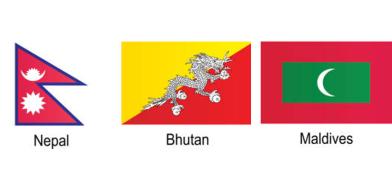The course of three South Asian democracies - Nepal, Bhutan and Maldives
After a decade, these three countries - Nepal, a Hindu majority country, Bhutan, a Buddhist country and Maldives, an Islamic country - make a compelling study in the journey of democracy, writes Rishija Singh for South Asia Monitor

The year 2008 saw three South Asian countries transition to democracy. Nepal turned into a republic, ending 250 years of monarchy. Bhutan became a trailblazer, as the first country in the subcontinent that saw “democracy from above,” with the Monarch abdicating his powers in favour of electoral democracy. The Maldives did away with a dictatorship that was in place since 1961.
None of these cases come without caveats. Nepal is still struggling to establish a well-functioning democracy and its constitution drafting process was mired in controversies. The benevolence of Bhutan’s monarchy is not without a flipside. Maldives did away with authoritarianism only to find itself sliding back into its vortex again. The latest election result, however, rekindles hope for democracy in Maldives.
Although the spectre of authoritarianism and threats to democracy are looming large across the world, these three small South Asian countries make an interesting case for resilience. After a decade, these three countries - Nepal, a Hindu majority country, Bhutan, a Buddhist country and Maldives, an Islamic country - make a compelling study in the journey of democracy.
Nepal ended a 10-year long civil war with Maoist insurgents in 2006 and became a republic in 2008. However, Nepal struggled with drafting a democratic constitution and, when a Constitution was finalised, it failed to reconcile Nepalese society and left it as divided if not more than earlier. The Constitution left the Madhesis, Tharus, Dalits, indigenous people, religious minorities and women dissatisfied and disappointed and even saw sporadic violence in the country. The citizenship clause relegated Madhesis and women to second class citizens. The secularism clause is written in a way intended to please every quarter while actually drawing their ire. The situation has reached a stalemate because of the maximalist positions taken by each party. Women activists are agitating for an equal right to pass on citizenship rights to their children irrespective of the father’s national identity, but to no avail. Nepal had the fortune of escaping colonialism; however, it could not become a matter of envy as the spectre of colonialism has haunted its politics because of its peripheral position in relation to colonized territories.
Nepal did not inherit the colonial institutional and infrastructural apparatus, but it did inherit the legacy of being treated as an appendage by the neighboring state, India. It hasn’t been able to produce a single leader who has the weight and gravity to unite the country and draft a constitution which serves everyone. Most politicians shout unity by harping on anti-India rhetoric, which actually undermines the credibility of its domestic institutions.
Journalist Thomas Bell, in his first book ‘Kathmandu,’ has argued that Nepal has one of the largest number of NGOs in the world. However, this has not helped the common people much and has, instead, created a breeding ground for corruption. These are some glimpses of problems that Nepal faces in its journey to establish a smoothly functional democracy.
Bhutan transitioned from absolute monarchy to constitutional monarchy in 2008. This was not a result of any revolution but a conscious decision by the monarch. Democracy was considered as a ‘gift’ from the monarch without any demand from citizens. Bhutan’s democracy is the best example of controlled democracy and, according to author Matthew Joseph C., Bhutan’s “democratization project” is meant to silence the demand for real democracy that was raised by Bhutanese who were later expelled from the country for their quixotic demand. The monarch’s move not only delegitimized the critics by adopting democracy, it also managed to maintain the monarchy’s position by introducing the feeblest version of it. Bhutan got away with most of its draconian measures, be it ethnic cleansing of the Lhotshampas, to banning its pro-democracy activists from entering, without inviting international scrutiny and criticism that it otherwise deserved, largely because of its harmless image as a peaceful Buddhist country. Article 2 of the Constitution prohibits any amendment of the monarch’s constitutional powers. The National Security Act of 1992 bars citizens from speaking against the king, people, and the country. These measures exemplify the controlling nature of Bhutan’s facile democracy.
Maldives turned from an authoritarian country to a democracy in 2008, after 30 years. However, it soon slid back to authoritarianism after its democratically elected President Mohamed Nasheed was forced to resign after phony terrorism charges under massive international scrutiny. He was succeeded by Abdulla Yameen, who ruled the way he usurped power, undemocratically. He took over various institutions, but the worst victim of his undemocratic move was the judiciary. He changed laws to fill the Supreme Court with judges favourable to him. He subsequently imprisoned most of his political rivals including Nasheed and former President Maumoon Abdul Gayoom, who is also his half-brother. Political thinker John Keane called this phenomenon ‘New despotism’, though he argues it for a “future world where governments backed by democratic rhetoric and electoral victories expand their executive power through massive economic nepotism, media controls, strangled judiciaries, dragnet surveillance and armed crackdown on opponents.” This finds resonance in countries like Maldives and Bangladesh. The recent election which saw the victory of Ibrahim Solih, reinforced the case for democracy in the country.
These case studies show the resilience of these countries in their troubled path to democracy. Scholar Ayesha Jalal differentiates between substantive democracy and electoral ones, where the former guarantees freedom of speech and expression and basic rights, while the latter stands for minimal participatory elections. These three countries, though, have achieved that minimalist position; they still have a long way to go to becoming substantive democracies.
(The writer is pursuing her PhD in South Asian Studies at Jawaharlal Nehru University, New Delhi. She can be contacted at rishijasingh24@gmail.com)









Post a Comment